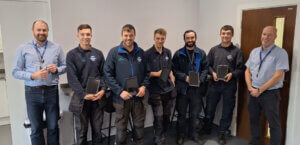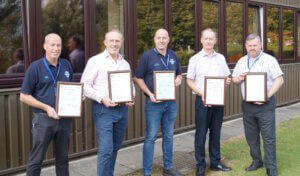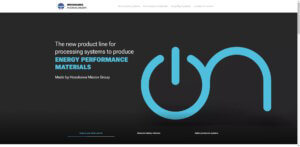
Provision of a controlled environment, which provides barrier isolation from potential cross contamination of the product and compounds harmful to personnel and the environment, is seen as a significant requirement in GMP industries.
Whilst demand for containment solutions in the pharmaceutical industry remains a key focus for containment solution providers there is a new escalation in demand from industries such as food, chemical, cosmetics and detergent that brings its own challenges. Positively these challenges are driving innovation in containment solutions and bringing new growth to a market dedicated to evolving technology to meet the most stringent controlled environment demands.
Explains Ben Jackson, a member of the Containment Team at Hosokawa Micron Ltd, ‘The sheer variety of isolator applications has gathered pace as manufactures address their health and safety obligations, in line with government regulations and GMP principles. With each new development, the scope of contained processing capabilities expands further and an eager market awaits with increasing expectations and an appetite for the manufacturing opportunities created. The challenges facing containment solutions providers have never been so great and here we identify those challenges and how we and others are addressing them.’
Lower Operator Exposure Levels
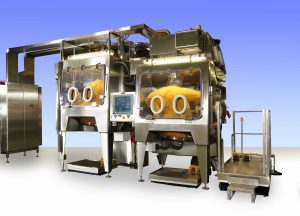
The development of increasingly potent and potentially toxic pharmaceutical products and chemicals remains a key driver in the development of isolator/gloveboxes capable of achieving ultra-low OELs (down to 10ng/m3 and Operator Exposure Band 6). With operator safety of paramount importance, the challenges of delivering even lower operator exposure levels will continue to push radical technology advances.
Today containment levels, previously only seen in the pharmaceutical industry are now being adopted into other industries; each with its own industry specific standards, manufacturing procedures and applications and codes of practice. The complexities of transferring isolator technology into different processing applications is not straight forward.
For example, when designing an isolator/glovebox it is not just the normal operating conditions which need to be considered but also safety under failure which may cause exposure to hazardous materials – this could be failure of the process or failure of the containment itself such as a breach condition e.g. a glove being ripped or similar. Failure to address safety under failure could be catastrophic.
Process Complexity
GMP manufacturers are no longer simply seeking an enclosure to provide a contained environment around their processing activities but increasingly seeking fully contained process solutions that deliver a streamlined production route to multi-process integration.
The increasing complexity of manufacturing stages addressed under containment and the demand for multi-task, operational integration is one of today’s chief drivers of isolator innovation and process system design change and for best result requires combined processing expertise as well as containment know-how.
This available expertise is now in much demand by customers seeking production and commercial advantages through the revolutionary changes in production that the new contained, complex process system opportunities can offer and is delivering a real step-change in containment innovation.
The challenges of integrating multiple pieces of equipment within a containment solution include issues with layout of the equipment and the process, size and operation of the equipment and access to it. To facilitate such integration Hosokawa has redesigned and scaled their mixer and mill portfolio to address some of the issues of installation and cleaning within isolators. A critical requirement in GMP industries, Clean in Place is the preferred option to removal of equipment for external cleaning, with its contamination risk. With this in mind, for example, Hosokawa has designed its mills for easier cleaning – often in crevice free Monobloc design. Through the wall designs mean all mechanical and electrical services are out of the clean area to facilitate cleaning and maintenance and ensure product integrity. The issue of machine accessibility has been addressed using redesigned mill openings using cantilevered arms and single finger door hinges that take the weight of door allowing the operator to hold the door with one finger – a real advantage when working through a glove port.
Production Flexibility
Production flexibility is very much a driving force across manufacturing in today’s consumer orientated world. Rapidly changing consumer demand means production agility and nimble response is vital. The accommodation of a variety of tasks and volumes handled is increasingly a significant, flexibility, game changer in capital investment decisions when it comes to containment solutions. Here we explain how flexibility issues in contained manufacturing have influenced two very different design solutions.
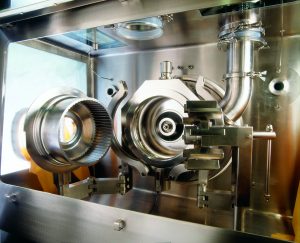
When a leading pharmaceutical manufacturer saw the opportunity to future proof complex API production through more flexible production combined with the chance to enhance operator protection this led to the commissioning of a contained API Particle Size Reduction Facility, from Hosokawa the ultimate in flexibility was incorporating interchangeable, multi-powder, ultra-fine particle size reduction with three skid mounted mills.
Multi-feed options of screw feeder, rotary valve and manual hopper feed delivered the flexibility of large and small batch capability. The dual-celled operation delivering operator exposure levels of <1µg/m3 was the first size reduction facility of its kind to offer such high levels of ‘complex but not complicated’ operational flexibility that is crucial in today’s fast moving and competitive market.
Drum, keg, box, can – increasingly the market demand is for contained systems that offer flexibility of handling raw materials presented on many ways. This could be down to cost effective purchasing opportunities or recipe ingredient fluctuations or onward processing demands.For a dye manufacturing company, a request for a containment system designed to offer safe, flexible handling operations across inconsistent drum sizes, and the opportunity to eliminate manual intervention in reactor charging, delivered opportunities for operational change and greater production flexibility that would significantly benefit the business and its workers.
An isolator chamber mounted directly above the reactor vessel enabling product transfer by gravity, has eliminated manual intervention. This system allows the presentation of drums and kegs of different sizes and weights to the isolator via a roller track. Drums are connected to a drum tipper, de-lidded and bags opened before special container clamps suitable for handling a range of weights/sizes attach the drums to the lifting/tipping device. The drums are then automatically lifted, rotated and dropped onto the reactor where they are located into position to secure and reduce dust creation on discharge. The system is operated under a nitrogen blanket to minimise dust explosion risk and is engineered for ATEX compliance with drum lifting and rotation operated by intrinsically safe air motors.
Ergonomics & Human Factor Engineering
Operation of a process within a containment solution can be very restrictive and the design of isolators can have a large impact on human performance. Designing tasks, equipment and isolator work stations to suit the user can reduce human error, accidents and ill-health. The potential impact of isolator operatives working on more complex and possibly lengthier manufacturing processes can only increase the demand for more ergonomic designs.
By combining ergonomics with human factor engineering isolator manufacturers can ensure the best possible design solutions for operator and manufacturing performance and health and safety. A thorough investigation and understanding of the working processes involved from the end user perspective is vital and can only be achieved through a close working partnership between customer and containment solutions provider.
Hosokawa combine early design stage, human factor engineering and wooden mock-up trials with smart manufacturing technologies to determine the customer’s absolute requirements and confirm specification before fabrication takes place – saving both time and money in costly positional changes and unplanned re-build stages and help ensure a user friendly, safe performance workplace.
3D and airflow modelling are invaluable for complex, multi-use operations, showing how equipment and personnel placement can potentially compromise airflows and scheduled tasks. The implementation of the latest Virtual Reality technology allows visualisation of a virtual isolator or full processing system for demonstration and assessment prior to manufacture. This is particularly welcomed by customers seeking commercial advantage through process design changes, complex operational requirements and those with integrated installations or those installations ‘shoe-horned’ within existing process lines or restricted spaces.
Case Study – Small Scale Liquid Dosing
This brief case study illustrates the variety of containment requirements, issues involved and the innovation and customer/supplier partnership behind the most appropriate design solutions.
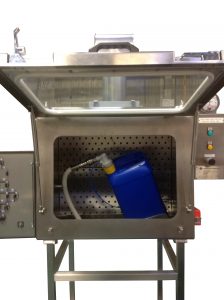
Hosokawa Micron has delivered a bespoke small scale, liquid dosing solution to eliminate operator exposure during raw material dosing and denaturing of containers, which enabled direct dosing into a mixer. Moving away from conventional, more expensive, IBC based, large dosing systems the design meets the customer demand for short batch cycle times, high dosing accuracy and variable container supply format of raw materials.
The small, low cost dosing system developed for the closed (sealed) dispensing of hazardous chemicals from jerry cans, drums and IBCs. Raw material containers are placed inside the ventilated box where the container cap is removed. The dosing system and integrated dip-pipe is screwed onto the top of the container. Hosokawa redeveloped and integrated the dip-pipe to ensure the inlet is located within one of the wells inside the container – for optimum and repeatable emptying.
The door on the ventilated box is closed and fully safety interlocked, before a button operated, optimised top pressure, is applied to the container and raw material is dosed safely into the mixer. The hose from the dosing system is disconnected (dry break connection) and CIP nozzle connected for cleaning and denaturing of transfer line and container.
Ongoing Innovation
Hosokawa is currently addressing a number of enquiries for complex processing solutions when containment is disrupted by the demand to take certain manufacturing stages out of the contained environment for another processing step before a return to containment for further processing. Without an understanding of the processes and technology involved in the manufacturing phases; an integrated solution cannot be achieved.
‘As customers change their production systems to meet market demands, new routes to safe handling are in demand. Our in-house expertise and process knowledge and flexible approach to design options allows us to develop practical containment solutions that meet and frequently exceed customer expectations,’ explains Ben Jackson, Hosokawa Micron Ltd.
Downloadable PDF: Containment Challenges Driving the Pace of Innovation to Satisfy Increasing Manufacturing Appetite
